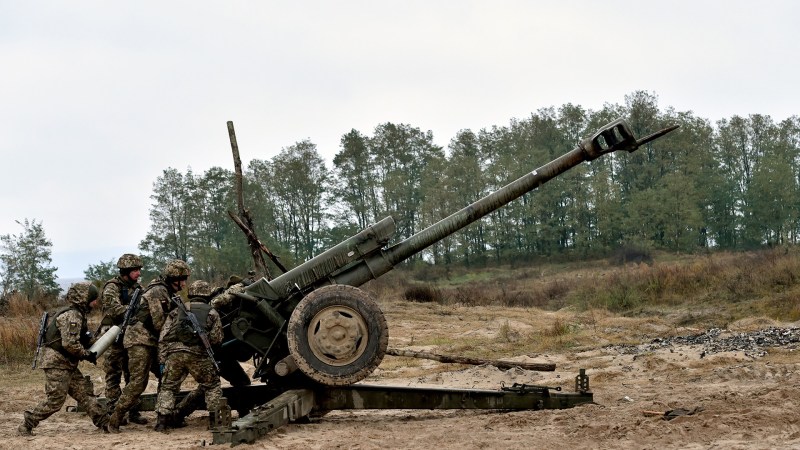Two weeks ago, an image appeared on Instagram on a new account titled “saintjavelin.” The image was of a woman wearing a green mantle and holding a Javelin anti-tank missile launcher with a blue halo and the symbol of the Ukrainian armed forces. The image was commissioned by a Canadian named Christian Borys, and within hours Borys was swamped with requests for merchandise of “Saint Javelin.”
“I posted it at like 11:45 p.m. Two orders came in right away,” Borys told the Canadian Broadcasting Corporation in an article last week. “And then the next day, it shot to like a thousand, and I was like, ‘Holy shit, this is crazy.’”
A marketing executive and filmmaker based in Toronto, Borys lived in Ukraine from 2014 to 2018 while working as a journalist, CBC reported. He told the publication that he is still in touch with friends he made there, and he wanted to find a way to help. Borys said he was inspired by his father, who lives in a Polish city called Przemyśl, right on the border with Ukraine. Borys’ father began housing Ukraininan refugees from the war in apartments he owns and eventually in his own home, CBC reported.
“He’s called me bawling a few times,” Borys said. “We sent a number of kids to his house the other day, and they’re all the children of guys who have stayed back to fight…he called me this morning, crying, saying, ‘These kids are asking me, ‘Where’s daddy? Where’s daddy?’”
Borys said that the experience inspired him to launch a fundraiser for children. He had a designer create a hundred stickers of Saint Javelin, the revenue for which he planned to donate to Ukrainian kids in need.
“I thought I was going to have a couple of stickers on my car,” he said. “I thought I was going to convince some friends to give me ten bucks and then I could donate, you know, $500 or something like that.”
But, like the missile for which it is named, the image really blew up.
“As soon as I posted the artwork on Instagram Stories, I just got a flood of people saying, ‘I want it, I want it, I want it,'” he recalled.
Borys set up a Shopify website to sell the stickers. At first he promised that 100 percent of revenue would go toward supporting children of Ukrainian soldiers killed in the war. However, when demand for the stickers and the ensuing t-shirts, flags and hats went viral, Borys said he had to use some of the revenue to cover the expense of creating them.
“I realized, ‘OK, well, this can’t be a percent of revenue anymore because I’m going to go broke,’” he told CBC. “But I switched it to 100 percent of proceeds.”
The remaining funds, after overhead costs, will go to Help Us Help, a Canadian charity that sends medical supplies, education support, and relocation and evacuation help to Ukrainians, Borys wrote on the Saint Javelin website. As of March 1, Borys raised $600,000 Canadian (equivalent to about $470,000 U.S.) in revenue, according one of Borys’ Instagram posts.
“10 days ago, I wanted to do something for my friends in Ukraine,” Borys wrote on Instagram on March 1. “Tomorrow, I get to write a cheque for $350,000 to Help Us Help, and that’ll just be the first one.”
The success of Borys’ image speaks to how much support people around the world feel for the people of Ukraine. But it also speaks to the power of the image and its symbols. For example, the Javelin is one of the best icons for the international community’s support of Ukraine against Russia, Borys explained.
“Ukraine requires assistance from NATO countries, especially the U.S,” he told CBC. “So the U.S. provided the Javelin, which is an anti-tank defensive weapon system, and it became a symbol of support for Ukraine in this tremendous war that they’ve, by no fault of their own, been dragged into by Russia.”
More than 17,000 anti-tank weapons have been reportedly sent to Ukraine by the U.S. and NATO. Among those weapons, the Javelin is one of the most effective, especially against enemy armor. It takes only 20 to 30 minutes to learn how to use one, the targeting pod feels like a video game, and Russian convoys winding through Ukraine without air support are sitting ducks to fire on. The Javelin can even be used against slow or low-flying aircraft.
“The Javelin, where it’s effective is: I see it; I shoot; then I can run away, reload, and get ready for another one – and that weapon is most likely going to hit the target,” said Marine Col. James W. Frey, a senior military fellow at the Center for a New American Security think tank in Washington, D.C. “By the time the enemy sees you, you’ve moved from your position.”

Over the past few weeks, the Javelin has become a star of memes posted on social media celebrating the weapon’s success against Russian military vehicles. But Borys’ image strikes new ground by giving the missile launcher religious significance. By associating the Javelin with archaic Christian imagery such as those found in stained glass windows or medieval paintings, Borys’ image promotes the Ukrainian cause as a righteous, sanctified one.
Weapons and religious imagery go way back. For example, medieval crusaders painted crosses on their clothes and shields. Even today, U.S. troops exchange challenge coins recasting former Secretary of Defense and Marine Corps general James Mattis as “Saint Mattis of Quantico” where the Marine holds a hand grenade beatifically and wears Marine-patterned camouflage style vestments.
But Borys’ image is even more powerful because of the person wielding the Javelin. CBC reported the subject was Mary Magdalene, one of Jesus’ followers. For much of human history, women were not represented as warfighters as often as men, but this image seems to change that pattern. The image of Mary Magdalene holding a Javelin also resonates with Ukraine’s mass-mobilization to fight against Russia, which further reinforces its cause as a popular and righteous one.
However, the image of Ukrainian women fighting the nation’s enemies actually goes back even further than Saint Javelin. As Borys pointed out on Instagram, St. Olga of Kyiv, Ukraine’s capital, is said to have killed dozens of members of the Drevlians tribe after they killed her husband. Yes, you can buy a sticker of St. Olga wielding a Javelin.
Whether or not you want to over-analyze it, the spread of Borys’ image shows that people around the world are eager to help Ukraine. However, it may be difficult for most folks to send the kind of help many Ukrainians need most urgently: weapons. After all, the $300,000 Canadian that Borys sent to Help Us Help is equivalent to about $273,423 American, which can buy only one $175,203 Javelin missile, according to an Army budget document from 2020. But people still need aid from folks like Borys to help with what comes afterward: the human cost.
“I’m a writer and it’s hard to put into words what this feels like,” Borys wrote on Instagram about the outpouring of support. “Thank you for your support and God Bless Ukraine. Slava Ukraini!”
Correction: An earlier version of this story misidentified St. Olga as the patron saint of Kyiv. The patron saint of Kyiv is St. Michael.
What’s new on Task & Purpose
- What we know about the Russian general killed in Ukraine
- Where is the Russian air force? Experts break down why they might be hiding
- Meet Army Col. Daniel Blackman, the accidental face of romance scams around the world
- An urban warfare expert offers Ukrainians tips on battling Russians in close combat
- How the US can beat Russia in Ukraine without firing a shot
Want to write for Task & Purpose? Click here. Or check out the latest stories on our homepage.

























